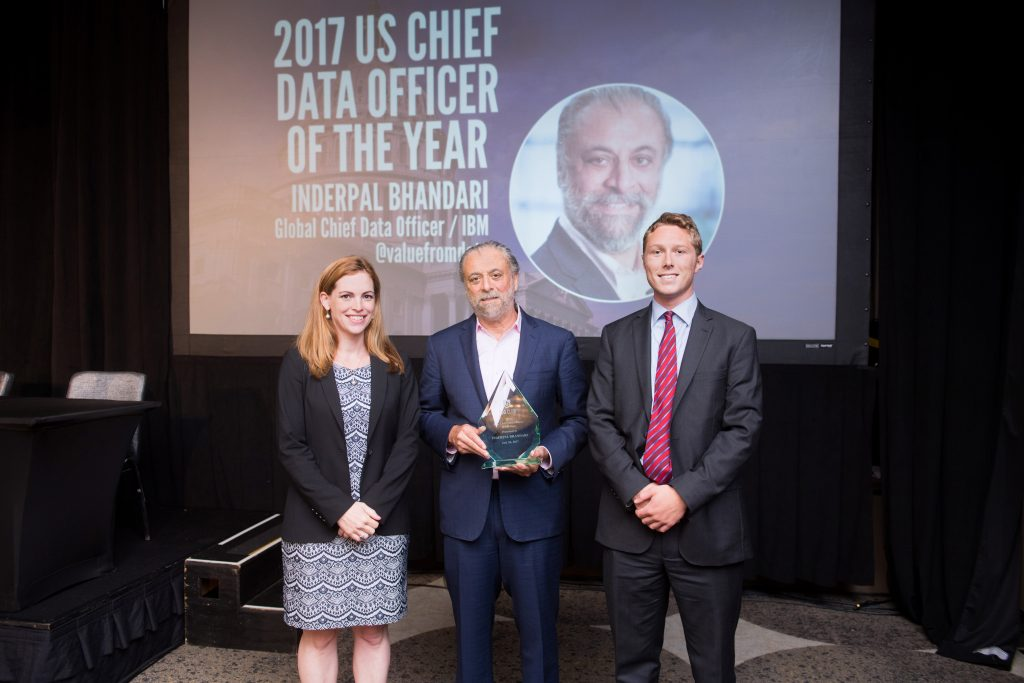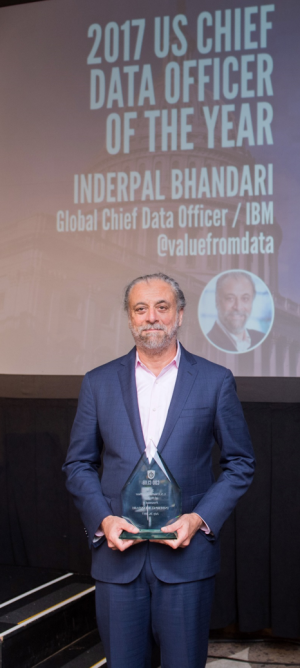
One on One with the CDO of the Year

What does it mean to be a chief data officer in 2017? We asked Dr. Inderpal Bhandari, who was just named the United States CDO of the Year last week by the CDO Club, for insight into the job.
Dr. Bhandari, who is the global chief data officer for IBM in his second stint with the firm, sat down with Datanami earlier today to share his views on the award, balancing data and analytics, and the evolving role of the CDO’s job. Here’s a lightly edited transcript of the conversation:
Datanami: Congratulations on being named the US CDO of the year for 2017 by the CDO Club. What does the honor mean for you at this stage in your career?
Dr. Inderpal Bhandari: I’m obviously greatly pleased by it, but also humbled, because I know this is coming from some really great people who make up the CDO community. The CDO Club, being constituted as it is of many people who are essentially my peers — there’s really no better honor or praise than when it comes from peers. That makes me feel very, very good about that.
Within IBM, our whole mission is around cognition. [That] is completely changing the role of the CDO. We’ve been pushing that since I joined IBM in the last year and a half, so it’s a tremendous vote of confidence, I think, on the path we’re on.
Datanami: You’re only the second US CDO of the Year named by the CDO Club, following last year’s inaugural winner DJ Patil. That’s quite a high bar to clear for next year’s nominees, wouldn’t you say?
Bhandari: There are some great folks there. But the CDO role is a relatively new role. In 2006, I actually created the role in the whole field of healthcare. I was the first. As I recall there were only three others, so the community was just four people. There were two in banking and one in Internet.
The role has now taken on an increased importance and relevance because the CEOs are recognizing the importance of data in terms of being able to realize their own business objectives. So you’re seeing this position being staffed very rapidly since 2006 to where we are now where we’re approaching the 1,000 mark.
Datanami: I think it was Gartner who said we have crossed the 1,000 mark for CDOs and chief analytics officers. Gartner also predicted last year that 90% of big companies will have CDOs by 2019. Do you think we’re on track to hit that number, to exceed it, or to come up short?
Bhandari: I think we’ll hit it. Another survey I saw found as many 75% of CEOs think that AI is going to be extremely relevant for their enterprises. The data is really a precursor into that. We will hit that market if for no other reason than that there’s a lot of awareness around it now with the CEOs and it’s also critical to get this right, so I think they’re all beginning to realize, that to have the data and cognitive backbone for the enterprise has to be very sound.
Datanami: Data science is moving so quickly right now, particularly with deep learning techniques and cognitive computing. How are those technologies and techniques impacting the duties of the CDO?
Bhandari: In the early days the CDO or the CAO basically were relegated to being the king of the data warehouse. This was true as recently as three years or so back. The whole idea was to get data in, put it in the data warehouse, scrub it, clean it, have it fit for purpose. It was all about structured data then after that you let analysts acorns the company use it to derive insights.
Now the role has changed. There’s a lot more unstructured data than we ever used before…It changes everything: the technology you need, the organization, the processes that you need. And there’s also a lot more external data that’s being brought in, things like news feeds, press releases, journals — any source of knowledge that’s captured in text or imagery or something like that is now fair game to bring in.
That’s changed on the input side, it’s changed the purview of the CDO, and what they need to be dealing with and proficient at bringing in and utilizing. And then on the outcome side, instead of popping up a warehouse and having the analysts have ready access to the data, now it’s much more about actually transforming business process in the enterprise. Because the way we think about cognitive or deep learning or AI is it’s going to get embedded into every process within the enterprise.
So the work of the CDO doesn’t just stop at the warehouse now. It actually extends into enabling the process to be transformed. That’s another major change in the role of the CDO.
Datanami: There’s a natural tension between analytics and data, and sometimes this tension surfaces in decisions that companies must make, such as whether to hire a CDO or a CAO. What argument would you use for backing the hiring of a CDO over a CAO?
Bhandari: This is my fourth go around in this role. I’ve run it where I have both data and analytics. I’ve run it where I just have data. And in other cases I’ve run it where I just have analytics. You’re right — that tension is there. One way you resolve the tension is you bring it all together. The other way you do it is the CDO and the CAO have to have a very good working relationship, as does the CDO and the chief information officer.
If you have three people with this role, then have to have good close working relationships across them to pull it off. To some extent if you’ve got a CDO and they’re just relegated to data, then they really can’t enable the analytics office effectively.
Datanami: What are some of the key attributes that companies should look for when looking to hire a CDO? What attributes makes a successful CDO?
Bhandari: I view this job as a craft because I’ve done this four times. There are five steps, three that run sequentially and two that happen in parallel with the first step.
The first step really has to do with essentially understanding the business strategy of the company. Not the data strategy or anything like that – the business strategy. How does the company trying to make money in the near future? Not necessarily how it makes money today, but in the future.
In the case of IBM, it’s all around cognition. That’s our business strategy. So the data strategy much be tied to enable that business strategy. For instance in my case at IBM, our data strategy is essentially to enable the IBM enterprise to become cognizant itself and then use that as a showcase for our customers.
The second step is they need to set up a governance framework to make sure that the data needed to drive the data strategy is actually fit for purpose. So in the case of cognition, you also need unstructured data, so you’ve got to bring that in. It has to be curated. You’ve got to essentially have a very deep understanding of data management to be able to pull that off.
Third, some data you really want to standardize and centralize because it’s so critical. In our case, our client data is like that, and so we standardize that and centralize that. Now you’re talking about data lakes and data repositories and having those types of skills, and enabling those with deep learning and data science pipelines.
The other two that run in parallel [are as follows]: First you have to really establish deep partnership with the business units. Often I’m sitting around the table and I think I don’t really own anything because all the process are owned by somebody else. And then at times I the I actually own everything with all the data flowing into those process, they’re part of my purview.
Lastly you have to be able to attract talent. Talent in this area is hard to come by. You can’t rely on the usual approaches just because the field is changing so fast and rapidly.
Datanami: You’re on your second tour with IBM. What can you tell me about the company’s data culture? How is Big Blue utilizing data to improve its products and services?
Bhandari: My first job within IBM was also around data. In fact that’s what started me into data mining and I ended up creating this program called Advanced Scout that used by every coach in the National Basketball Association. That was an IBM research project. I was part of the Watson research unit at that time. Then I left and did my own company and then I created this role of CDO in healthcare and stayed there.
IBM has always been extremely focused on data from an early time. When I did this stuff two decades or so ago, that was Moneyball way ahead of its time. That’s because IBM was already thinking about that and doing that. They’ve got that same focus now even more so because of the whole thrust around cognition. Our role there is cognition in the enterprise is very different than how you experience it as a consumer.
We are after those foundational use cases that will enable an enterprise to become cognitive, and that’s all around the enablement of data…We understand that this is going to be a critical and fundamental aspect of an enterprise as you move forward, that the use cases around being a trusted partner and purveyor of technology and methodology and services in this area is going to be critical. So it’s total holistic thinking around data and cognition from the standpoint of an enterprise. That’s what I see right now.
Datanami: Thank you for sharing your insights with us.
Related Items:
CAO or CDO? Analytic Institute Examines Differences
One on One with IBM’s Global VP for Data Analytics






























